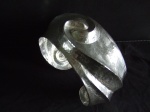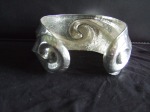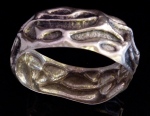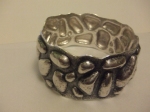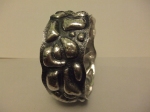- Circle of life cuff bracelet showing high relief
- another angle that clearly shows the silver pushed up from inside and shaped from the front
- From the inside the ‘negative’ equal and opposite swirl pattern made by initially pushing from beneath
- Here you see the lines pushed back to create the more defined lines whilst the pattern is chased back
- Another good visual example of the dual techniques of chasing and repousse, I will mention this piece-heart on your sleeve- in another post
- Again shown here to highlight just how malleable silver is
- This commission piece was made to replicate pebbles on a beach. I hope you agree that repousse and chasing are fine techniques to make these more individual one off sculptural jewellery pieces.
The images shown here give examples of chasing and repousse used for jewellery. I use these for those of you not familiar with this technique
The first picture is of a cuff bracelet, I will write another post to explain the thinking behind this design so as to keep on topic regarding definitions of working that I wish to convey here.
The repousse part of the process is working from inside or behind the risen part of the design, the making of the peaks if you will. Some work is created using just the repousse stage it would tend to be higher in relief and oftentimes not as well defined. If you look up examples of Newlyn copper from the arts and crafts period, this is a good example.
Chasing is working entirely from the front of the piece to create more definition. Traditionally chasing is much finer and more akin to engraving, used to convey more recognisable, less abstract designs. As in many things this is a very loose approximation. I think it helpful to explain it as definable lines can be imprinted into the metal with chasing, whilst repousse is much softer and less textured.
I will post again with examples of chasing and repousse tools. Also I will show some examples of early experimentation with designs using the swirl cuff as an example. This is to give you a little insight into the thinking behind the design and the prototypes I usually make in copper, looking to see if the design is worthwhile before committing to silver. If anyone wants more clarification or would like to add anything, I would be delighted to hear from you.
Until next time, very best wishes.
Stu Art


